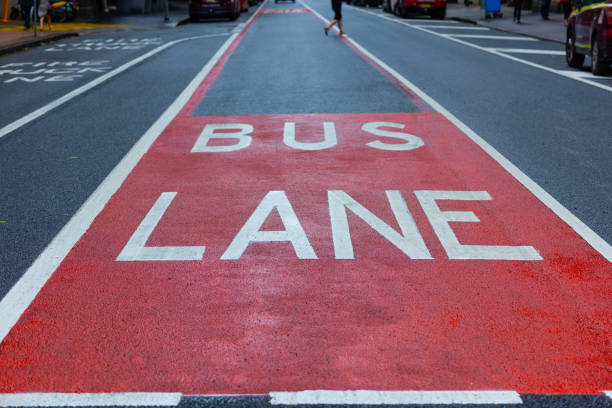In this article, we will explore the importance of knowing bus lane and transit lane rules in New South Wales. NSW bus lane rules include the following topics:
- the types of bus lanes,
- allowed usage of bus lanes,
- penalties for non-compliance, and
- disputing a fine for violation of the rules.
Navigating the bustling streets of NSW can be a challenging endeavour, especially during peak hours. However, understanding and adhering to the bus lane rules can make your journey smoother and more efficient.
What Is a Bus Lane?
A bus lane in NSW is a designated lane on the road that is reserved for buses and other authorised vehicles. They have bus lane signs at the start of these lanes. Here are some key points about the rules on bus lanes in NSW:
- Only buses can use bus lanes, but some other authorised vehicles can use them, such as:
- taxis,
- hire cars with HC number plates,
- special purpose vehicles operated by or under the direction of Transport for NSW responding to an emergency,
- bicycles, and motorcycles.
- Except for buses at a bus stop, taxis, and chauffeur-driven hire cars picking up or dropping off passengers, you cannot stop in a bus lane.
- If there is a sign allowing vehicles or if there is an impediment, other vehicles may enter a bus lane to circumvent it. To enter or exit the road, pass another vehicle turning right or making a U-turn, or enter a lane from the side of the road, they can also drive in a bus lane for a maximum of 100 metres.
- When it comes to bus lanes, breaking the law might result in a costly fine. The NSW Road Rules 2014 provides for the penalties, which will be discussed in the following sections.
Types of Bus Lanes NSW
There are different types of bus travel lanes in NSW. Here are the details based on the search results:
- Bus Lanes (B Lanes): Bus lanes are for public buses and, in some cases, only for authorised vehicles mentioned in the preceding section.
According to NSW Road Rules, a public bus can use the B Lanes. A public bus is a motor vehicle that is:
- constructed principally to carry persons, and
- equipped to seat more than eight adult persons, and
- used to convey passengers for hire, reward, or in the course of trade or business.
- Bus Only Lanes: Only public buses or emergency vehicles can use a “Bus Only” lane. These lanes are on major thoroughfares and highways. It aims to give buses a quicker and more effective means of public transport.
- T-way Lanes: T-way lanes are special lanes similar to bus lanes but are designed specifically for bus rapid transit systems. These lanes are for authorised buses and service vehicles.
Are There Instances When Drivers Can Use Bus Lanes in NSW?
Yes, there are specific instances when drivers can use bus lanes in NSW. According to the NSW Road Rules 2014, a driver (except the driver of a public bus) must not drive in a bus lane, unless the driver is permitted to drive in the bus lane under rule 158.
Rule 158 states that “The driver of any vehicle may drive for up to the permitted distance in a bicycle lane, bus lane, tram lane, transit lane or truck lane if it is necessary for the driver to drive in the lane:
- to enter or leave the road, or
- to enter a part of the road of one kind from a part of the road of another kind (for example, moving to or from a service road, the shoulder of the road, or an emergency stopping lane), or
- to overtake a vehicle that is turning right, making a U-turn from the centre of the road, and giving a right change of direction signal, or
- to enter a marked lane, or part of the road where there is room for a line of traffic (other than motor bikes, bicycles, motorised wheelchairs or animals), from the side of the road.”
Moreover, other vehicles can drive in a bus lane to avoid an obstruction or if there is a sign saying they can. They can also drive in a bus lane for a maximum of 100m to enter or leave the road, overtake another vehicle turning right or making a U-turn, or enter a lane from the side of the road.

Penalties for Driving on a Bus Lane
The penalties for driving in a bus lane in NSW can include a fine and demerit points. Both bus lanes and bus-only lanes have a maximum penalty of 20 penalty units. In NSW, this would equate to 20 x $110, which is equal to AUD 2,200 currently.
Disputing a Fine for Driving in a Bus Lane in NSW
Yes, if you receive a fine for driving in a bus lane during restricted hours in NSW, you have the option to dispute it. You can do this by:
- requesting a review of the fine or
- by electing to have the matter heard in court.
If you believe that you have been unfairly fined, it is worth considering your options for disputing it. However, disputing a fine does not guarantee that it will be overturned.
Process of Disputing a Fine
Here is the process for disputing a fine for driving in a bus lane in NSW:
- Request a review of the fine: If you receive a fine for driving in a bus lane during restricted hours in NSW, you can request a review of the fine. To do this, you will need to provide evidence to support your case, such as photos or witness statements. You can submit your request online or by mail.
The NSW government will thoroughly examine your application. They will take into account the nature of the offence and the supporting documentation you provide. Their decision will be based on the NSW Government Caution Guidelines and Internal Review Guidelines under the Fines Act 1996.
This guarantees that the procedure is impartial and upholds the NSW public’s expectation of road safety. Moreover, your fine will be suspended once a review has been submitted while they look at your request.
No action will be taken until a choice has been made and you have been informed of the result. You will also have to provide your contact number in case they need additional information about your request.
- Elect to have the matter heard in court: If you are not happy with the outcome of the review, you can elect to have the matter heard in court. However, you must seek legal advice before proceeding with this step. You can apply here.
Here’s an overview of the court process:
- The NSW Government will give you a Court Attendance Notice (CAN), which includes the location, date, and time of the mention at the court that is most convenient to the location of the commission of the offence.
- You’ll need to enter a plea either in person or in writing.
- The court will make a decision.

Talk to a Traffic Offence Lawyer
Traffic offence lawyers can help with bus lane rules violations in NSW in the following ways:
- Legal representation for drivers who have received a fine for driving in a bus lane.
- Assist drivers in disputing a fine for driving in a bus lane.
- Negotiate with the relevant authorities on behalf of the driver to reduce the severity of the penalty.
- Give legal advice to drivers on the specific rules and restrictions associated with each bus lane.
JB Solicitors has a team of experienced traffic offence lawyers who can help you in your case. Contact us today.
